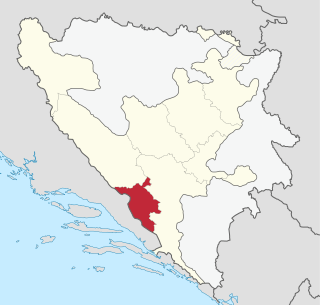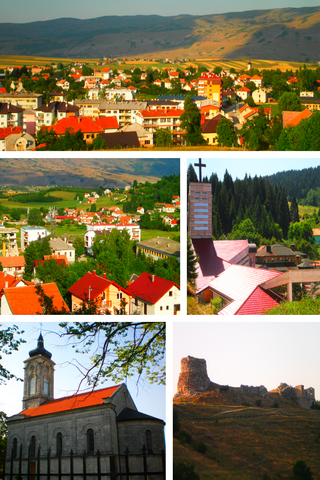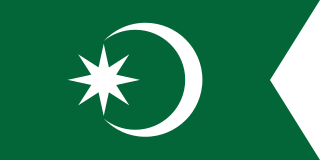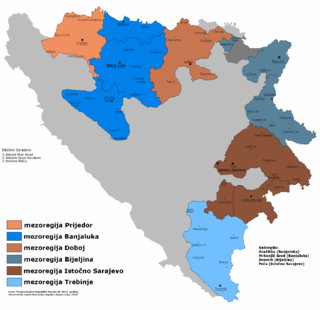Herzegovina or Hercegovina may refer to:

Bosnia and Herzegovina, sometimes known as Bosnia-Herzegovina and informally as Bosnia, is a country in Southeast Europe, situated on the Balkan Peninsula. It borders Serbia to the east, Montenegro to the southeast, and Croatia to the north and southwest. In the south it has a 20 kilometres long coast on the Adriatic Sea, with the town of Neum being its only access to the sea. Bosnia has a moderate continental climate with hot summers and cold, snowy winters. In the central and eastern regions, the geography is mountainous, in the northwest it is moderately hilly, and in the northeast it is predominantly flat. Herzegovina, the smaller, southern region, has a Mediterranean climate and is mostly mountainous. Sarajevo is the capital and the largest city.

Sarajevo is the capital and largest city of Bosnia and Herzegovina, with a population of 275,524 in its administrative limits. The Sarajevo metropolitan area including Sarajevo Canton, East Sarajevo and nearby municipalities is home to 555,210 inhabitants. Located within the greater Sarajevo valley of Bosnia, it is surrounded by the Dinaric Alps and situated along the Miljacka River in the heart of the Balkans, a region of Southern Europe.

Bosnia and Herzegovina is a country in Southeast Europe on the Balkan Peninsula. It has had permanent settlement since the Neolithic Age. By the early historical period it was inhabited by Illyrians and Celts. Christianity arrived in the 1st century, and by the 4th century the area became part of the Western Roman Empire. Germanic tribes invaded soon after, followed by Slavs in the 6th century.

Tuzla is the third-largest city of Bosnia and Herzegovina and the administrative center of Tuzla Canton of the Federation of Bosnia and Herzegovina. As of 2013, it has a population of 110,979 inhabitants.

Canton 10, is one of the ten cantons of the Federation of Bosnia and Herzegovina, a political entity of Bosnia and Herzegovina. It is the largest canton by area and eighth by population. The local government seat is in Livno, while the assembly is in Tomislavgrad. It is divided into five municipalities: Bosansko Grahovo, Drvar, Glamoč, Kupres, Tomislavgrad and one city, Livno.

Travnik is a town and a municipality in Bosnia and Herzegovina. It is the administrative center of the Central Bosnia Canton of the Federation of Bosnia and Herzegovina. It is situated in central Bosnia and Herzegovina, 90 kilometres west of Sarajevo. As of 2013, the town had a population of 15,344 inhabitants, while the municipality had 53,482 inhabitants.

The West Herzegovina Canton is one of the cantons of the Federation of Bosnia and Herzegovina. The West Herzegovina Canton is in the Herzegovina region in the southwest of Bosnia and Herzegovina. Its seat of government is in Široki Brijeg, while other municipalities within the Canton are Grude, Ljubuški and Posušje. It has 94,898 inhabitants, of whom more than 98% are ethnic Croats. Economically, it is the most developed part of Bosnia and Herzegovina.

Bosanska Krajina is a geographical region, a subregion of Bosnia, in western Bosnia and Herzegovina. It is enclosed by a number of rivers, namely the Sava (north), Glina (northwest), Vrbanja and Vrbas. The region is also a historic, economic and cultural entity of Bosnia and Herzegovina, noted for its preserved nature and wildlife diversity.
Herzegovinian may refer to:

Glamoč is a town and the seat of the Municipality of Glamoč in Canton 10 of the Federation of Bosnia and Herzegovina, an entity of Bosnia and Herzegovina. It is situated in southwestern Bosnia and Herzegovina, at the foothills of Staretina and Velika Golija mountains, and on the edge of the central part of the Glamočko Polje.

The Ottoman Empire era of rule in Bosnia and Herzegovina and Herzegovina lasted from 1463/1482 to 1878 de facto, and until 1908 de jure.

East Herzegovina is the eastern part of the historical Herzegovina region in Bosnia and Herzegovina, east of the Neretva river, part of the Republika Srpska entity. Major towns are Trebinje, Nevesinje and Bileća, predominantly inhabited by ethnic Serbs. West Herzegovina is the western part, west of the Neretva river, and is today administratively part of the Herzegovina-Neretva Canton and West Herzegovina Canton, predominantly inhabited by ethnic Croats, located in the Federation of B&H entity. The easternmost parts of historical Herzegovina lie in Montenegro, in so-called "Old Herzegovina", which became part of the Principality of Montenegro in 1878. In 1991, local ethnic Serbs of the region declared the territory of SAO East Herzegovina independent and joined other Serb territories into Republika Srpska by 1992. The meso-region has since been named Trebinje Region.
Bosnia primarily refers to Bosnia and Herzegovina, a country in southeastern Europe.

The Croats of Bosnia and Herzegovina, often referred to as Bosnian Croats or Herzegovinian Croats, are native and the third most populous ethnic group in Bosnia and Herzegovina, after Bosniaks and Serbs, and are one of the constitutive nations of Bosnia and Herzegovina. Croats of Bosnia and Herzegovina have made significant contributions to the culture of Bosnia and Herzegovina. Most Croats declare themselves Catholics and speakers of the Croatian language.

Old Herzegovina is a historical region, covering the eastern parts of historical Herzegovina, outside the scope of modern Herzegovina. A large section of Old Herzegovina belongs to modern Montenegro, while a smaller section belongs to the modern Bosnia and Herzegovina and modern Serbia. All of those regions were parts of historical Herzegovina from the middle of the 15th century until 1878.

Bosnia and Herzegovina fell under Austro-Hungarian rule in 1878, when the Congress of Berlin approved the occupation of the Bosnia Vilayet, which officially remained part of the Ottoman Empire. Three decades later, in 1908, Austria-Hungary provoked the Bosnian Crisis by formally annexing the occupied zone, establishing the Condominium of Bosnia and Herzegovina under the joint control of Austria and Hungary.

The Bosniaks are a South Slavic ethnic group native to the Southeast European historical region of Bosnia, which is today part of Bosnia and Herzegovina, who share a common Bosnian ancestry, culture, history and language. They primarily live in Bosnia, Serbia, Montenegro, Croatia, Kosovo as well as in Austria, Germany, Turkey and Sweden. They also constitute a significant diaspora with several communities across Europe, the Americas and Oceania.

Herzegovina is the southern and smaller of two main geographical regions of Bosnia and Herzegovina, the other being Bosnia. It has never had strictly defined geographical, cultural or historical borders, nor has it ever been defined as an administrative whole in the geopolitical and economic subdivision of Bosnia and Herzegovina.

Šuica is a village in the Municipality of Tomislavgrad in Canton 10 of the Federation of Bosnia and Herzegovina, an entity of Bosnia and Herzegovina.

Bosnia and Herzegovina–Turkey relations are the bilateral relations between Bosnia-Herzegovina and Turkey. Bosnia and Herzegovina is a southeast European country, while Turkey is a transcontinental country with a small European part on the Balkan peninsula around Istanbul. Diplomatic relations between the two countries started on 29 August 1992. Bosnia and Herzegovina has one embassy in Ankara and two consulates in Istanbul and İzmir, while Turkey has one embassy in Sarajevo and one consulate in Mostar. The two countries enjoy very warm diplomatic relations, due to historical and cultural ties dating back to the 15th century. There is a large population of Bosniaks in Turkey and a smaller community of Turks in Bosnia and Herzegovina. The Istanbul quarter of Yenibosna is named in honour of the Bosnian community that has settled there since Ottoman times. Reflecting the close ties between the two nations, Bosnians and Turks are free to travel to each other's countries using only their national identification cards, without the need for a passport. Turkey gives full support to Bosnia and Herzegovina's NATO membership.